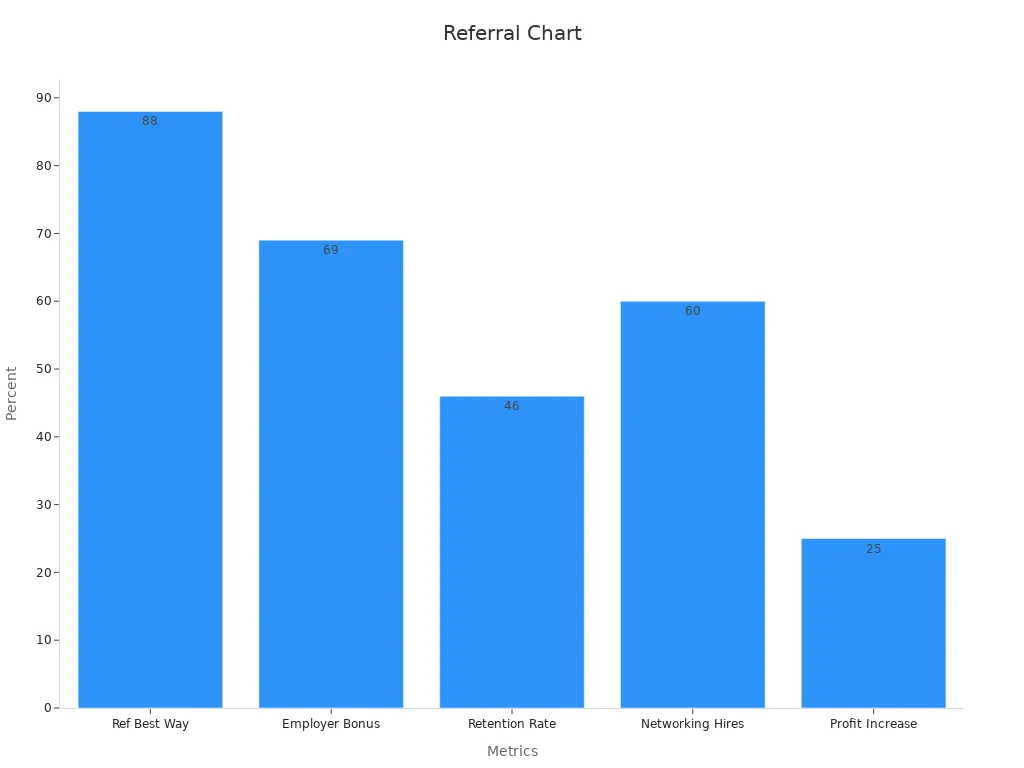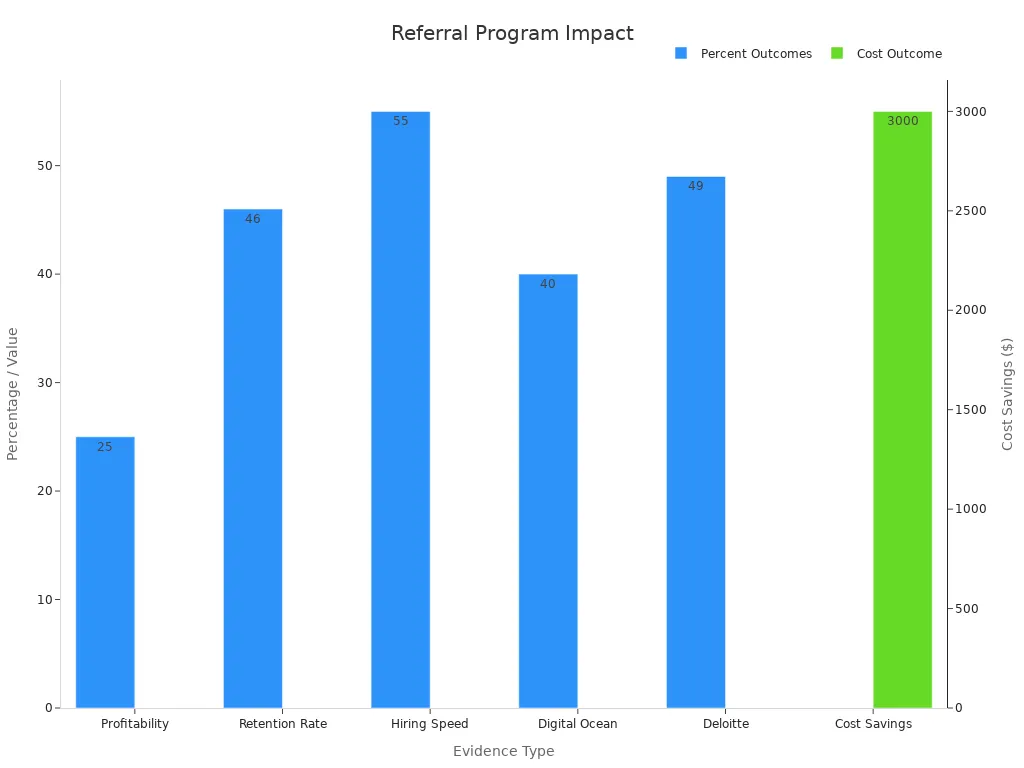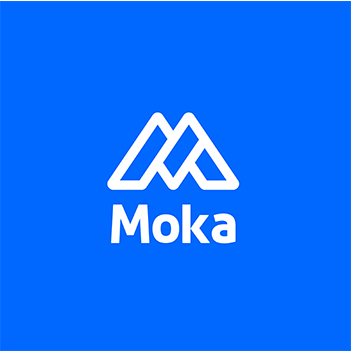How to Measure the Effectiveness of Employee Referral Programs in 2025

Employee referral programs have become a cornerstone of modern hiring strategies. Measuring the impact of these programs in 2025 is essential for ensuring their success. Data shows that 34% of referred candidates get hired, compared to just 2-5% from job boards. Referrals also reduce turnover rates by 20% and speed up hiring by nearly 50%. These numbers highlight the value of using data-driven strategies to optimize outcomes. How can you ensure your referral program delivers maximum results? By focusing on measuring the impact of employee referral programs, you can unlock their full potential.
Key Takeaways
Employee referral programs help hire faster. Referred workers are hired 55% quicker than usual methods.
Tracking numbers like referral rates and costs helps improve the program and match it to company goals.
Giving rewards like money or praise makes employees join referral programs more.
Checking and updating your referral program often keeps it useful for your company.
Using data can get better workers and keep them longer, making referral programs a great hiring tool.
What Are Employee Referral Programs and Why Do They Matter?
Definition and Purpose of Employee Referral Programs
Employee referral programs are structured initiatives that encourage employees to recommend qualified candidates for open positions within their organization. These programs leverage the power of personal networks to identify talent that aligns with company needs. By tapping into your employees' connections, you can access a pool of candidates who are often pre-vetted for cultural fit and job suitability.
The purpose of these programs extends beyond filling vacancies. They aim to create a collaborative hiring process where employees feel empowered to contribute to the company's growth. This approach not only strengthens your workforce but also fosters a sense of ownership and engagement among your team.
Benefits for Companies and Employees
Employee referral programs offer significant advantages for both companies and employees. For companies, these programs improve hiring efficiency and retention rates. According to research, referred employees have a retention rate of 42%, compared to 32% for hires from job boards and 14% from career sites. Additionally, the time to hire through referrals averages 29 days, significantly faster than the overall average of 44 days.
For employees, referral programs provide opportunities to shape their work environment by recommending candidates who align with the company culture. These programs also enhance team dynamics and morale, as employees often feel more comfortable working with individuals they already know and trust.
Hiring Method | Time to Hire |
|---|---|
Employee referrals | 29 days |
Overall average | 44 days |
Source | Retention Rate |
|---|---|
Employee referral program | 42% |
Job boards | 32% |
Career sites | 14% |
The Growing Importance of Measuring Effectiveness in 2025
In 2025, measuring the impact of employee referral programs has become more critical than ever. Modern referral technologies now allow you to track metrics like referral rates, candidate quality, and retention costs. These insights help you identify which departments generate the most referrals and which candidates are likely to succeed. By shifting from intuition-based decisions to data-driven strategies, you can optimize your hiring process and align it with your business objectives.
Metrics such as referral rate, quality and diversity of hires, and retention costs provide a comprehensive view of your program's effectiveness. For example, referral rates indicate employee engagement, while quality metrics reveal how well candidates fit their roles. Measuring these factors ensures that your referral program not only fills positions but also contributes to long-term organizational success.
Metric | Description |
|---|---|
Referral Rate | Measures employee participation in referring candidates, indicating engagement and culture health. |
Quality and Diversity | Evaluates the fit of referred candidates, impacting time-to-hire and recruiting costs. |
Retention Cost and Time | Tracks employee satisfaction and retention rates, influencing overall hiring expenses. |
By focusing on measuring the impact of employee referral programs, you can ensure they remain a valuable asset in your recruitment strategy.
Why Measuring the Impact of Employee Referral Programs Is Critical
Using Data to Improve Hiring Outcomes
Data plays a vital role in enhancing the success of employee referral programs. By analyzing metrics like referral rates, quality of hires, and retention rates, you can identify what works and what needs improvement. For example, referral candidates are three times more likely to be hired compared to other sources. This highlights the efficiency of referrals in finding suitable candidates. Additionally, referred employees often stay longer, reducing turnover and saving costs.
Metric | Description |
|---|---|
Referral Rate | Measures the percentage of new hires that come from employee referrals. |
Quality of Hires | Indicates the percentage of referred candidates that successfully pass screening and interview stages. |
Cost-Effectiveness | Highlights the average cost savings associated with hiring through referrals compared to other methods. |
Retention Rate | Shows the percentage of referred hires that remain with the company over a specified period. |
Time to Hire | Average duration from sourcing to onboarding a referred candidate. |
Using these metrics allows you to make informed decisions and refine your program for better results.
Aligning Referral Programs with Business Objectives
Aligning referral programs with your company’s goals ensures they contribute to overall success. For instance, Schneider Electric improved their internal candidate experience, raising their NPS score by 25.8 points. Similarly, a retail company increased referral rewards after noticing higher retention rates among referred hires. This adjustment led to a 40% increase in referral hires. By aligning your program with business objectives, you can achieve measurable improvements in hiring outcomes.
Avoiding Common Pitfalls of Unmeasured Programs
Unmeasured referral programs often lead to unintended consequences. Informal referrals may rely on homogenous social networks, excluding diverse candidates. Research shows that such practices can perpetuate inequalities and limit access for job seekers without connections. Employers who fail to measure their programs risk reinforcing biased hiring practices. By tracking and analyzing data, you can avoid these pitfalls and create a fair, inclusive hiring process.
Evidence Description | Impact on Hiring Results |
|---|---|
Informal referrals operate through ethnically homogenous social networks, disadvantaging job seekers without connections. | Leads to a narrowed labor market for excluded groups, perpetuating inequalities. |
Employers often maintain ethnically homogenous workforces through employee referrals. | Reinforces exclusionary hiring practices. |
Measuring the impact of employee referral programs ensures they remain effective, equitable, and aligned with your company’s goals.
Key Metrics for Measuring the Impact of Employee Referral Programs

Usage Metrics: Participation Rates, Number of Referrals, and Engagement
Usage metrics help you understand how actively employees participate in your referral program. These metrics include participation rates, the number of referrals made, and overall engagement levels. High participation rates indicate that employees find the program valuable and easy to use. For example, 88% of workers believe referrals are the best way to find top candidates, and 69% of employers offer referral bonuses to encourage participation.
You can also track how many job vacancies employees share on social media and the click rates on these posts. A high click rate reflects a strong employer brand. The table below highlights key performance indicators (KPIs) for usage metrics:
KPI Description | Interpretation |
|---|---|
Activity Rate | Percentage of active participants out of all who signed up. |
Job Vacancies Shared | Number of job vacancies shared by employees on social media. |
Click Rate | Number of clicks on shared job vacancies, indicating employer brand strength. |
Effectiveness Metrics: Quality of Hires, Retention Rates, and Performance
Effectiveness metrics measure the success of your referral program in delivering high-quality hires. Referred candidates are four times more likely to be hired compared to other sources. They also have a 40% higher chance of being hired and a retention rate of 46% after one year, compared to 33% for non-referred hires. These metrics show how well your program identifies candidates who fit your company culture and perform well in their roles.
Retention rates and employee performance are critical indicators of long-term success. By focusing on these metrics, you can ensure your referral program contributes to sustainable growth.
Efficiency Metrics: Time-to-Hire, Cost-Per-Hire, and ROI
Efficiency metrics evaluate how quickly and cost-effectively your referral program fills open positions. Referred candidates are hired 55% faster than those from traditional methods, with an average time-to-hire of 29 days compared to 55 days. This speed reduces hiring costs and improves overall efficiency. Referral programs also save companies $3,000 or more per hire, making them a cost-effective solution.
The return on investment (ROI) of referral programs is another crucial metric. Referred hires often lead to a 25% increase in profit, demonstrating the financial benefits of a well-optimized program.

By measuring the impact of employee referral programs through these metrics, you can identify areas for improvement and maximize their effectiveness.
How to Implement and Optimize Measurement Strategies
Setting Clear Goals and KPIs for Referral Programs
To measure the impact of your employee referral program effectively, you need clear goals and key performance indicators (KPIs). Start by defining what success looks like for your program. For example, you might aim to increase referral participation by 20% or reduce time-to-hire by 15%. Setting realistic targets early on helps you build a system that fosters loyalty and engagement over time.
A balanced rewards system can also motivate employees to participate. Offering diverse incentives, such as monetary bonuses, extra vacation days, or public recognition, makes the program appealing to a broader audience. Understanding what drives your employees through surveys or feedback sessions ensures your program aligns with their motivations. Additionally, tools like Net Promoter Score (NPS) surveys can help you gauge employee satisfaction and their likelihood to recommend the program to others.
Leveraging Technology and Tools for Tracking Metrics
Technology plays a crucial role in tracking and optimizing referral programs. Applicant tracking systems (ATS) simplify the process by automating data collection and analysis. These systems allow you to monitor key metrics like referral rates, time-to-hire, and retention rates. For instance, tracking the employee referral rate helps you understand how effective your program is in sourcing candidates.
Specialized software tools designed for referral programs can further enhance your tracking capabilities. These platforms often include features like event tracking, A/B testing, and detailed analytics dashboards. By using these tools, you can identify gaps in your referral funnel and make data-driven adjustments to improve outcomes. Customizing your referral program with these technologies ensures it remains efficient and effective.
Regularly Reviewing and Refining Programs Based on Data
Periodic reviews are essential for keeping your referral program aligned with your company’s goals. Start by monitoring key metrics such as referral-to-hire ratio, time-to-hire, and retention rates. These numbers provide a snapshot of your program’s effectiveness. Gathering feedback from employees, new hires, and hiring managers can also uncover areas for improvement.
Analyzing trends in successful referrals helps you refine your strategy. For example, you might notice that certain departments generate higher-quality referrals. Comparing your program’s results with other recruitment channels can also highlight its strengths and weaknesses. Regular reviews ensure your program evolves with your company’s needs. Updating incentives based on employee feedback keeps the program engaging and relevant.
Strategy | Description |
|---|---|
Monitor referral-to-hire ratio, time-to-hire, and retention rates to assess effectiveness. | |
Gather Feedback | Collect insights from participants, new hires, and hiring managers to identify improvement areas. |
Analyze Data | Look for trends in successful referrals to refine the program. |
Compare with Other Channels | Evaluate ERP results against other recruitment methods to gauge performance. |
Schedule Regular Reviews | Conduct periodic assessments to ensure the program evolves with company needs. |
Adapt to Changing Needs | Modify the program based on shifts in hiring focus or company growth. |
Refresh Incentives | Update rewards to keep the program engaging and aligned with employee feedback. |
By regularly reviewing and refining your program, you ensure it remains a valuable tool for measuring the impact of employee referral programs.
Examples of Successful Employee Referral Programs

Case Study: A Tech Company’s Data-Driven Approach to Referrals
Tech companies often excel at leveraging data to optimize employee referral programs. One standout example is Digital Ocean, where referrals accounted for 40% of hires by the end of 2017. This success stems from their focus on tracking metrics like tenure, referrer retention, and performance correlation. Employees who referred candidates stayed longer, showing a positive impact on retention. Additionally, top performers tended to refer other high achievers, creating a cycle of quality hires.
Deloitte also demonstrates the power of referrals, sourcing over 49% of new employees through its program. Their approach highlights the importance of using data to identify trends and refine strategies. By analyzing referral outcomes, they ensure their program aligns with organizational goals.
Metric | Evidence |
|---|---|
Referred employees' tenure | Referred employees stay longer than non-referrals, indicating a positive impact on retention. |
Referrer retention | Employees who refer candidates tend to stay longer at the company. |
Successful referral impact | Those who make successful referrals have longer tenures compared to those whose referrals are not hired. |
Performance correlation | Top performers tend to refer other top performers, indicating a link between performance and referral quality. |
Case Study: A Retail Company’s Innovative Incentive Program
Retail companies often rely on creative incentives to boost referral program participation. One example is a company that tracked metrics like referral-to-hire rate, time-to-hire, and cost-per-hire. Their program offered tiered rewards, motivating employees to refer candidates actively. This approach led to faster hiring and higher retention rates among referred employees.
The program’s success was evident in its metrics. Referred hires performed better and stayed longer compared to non-referred employees. The cost-per-hire also dropped significantly, saving the company thousands of dollars per hire. By aligning incentives with employee motivations, the program achieved measurable results.
Metric | Description |
|---|---|
Referral-to-Hire Rate | Measures the percentage of referred candidates who are successfully hired. |
Time-to-Hire | Indicates how long it takes to hire a referred candidate from referral to acceptance. |
Quality of Hire | Compares the performance of referred hires to non-referred hires. |
Retention Rate of Referred Employees | Tracks how long referred employees stay compared to non-referred employees. |
Cost-per-Hire (CPH) | Measures the cost-effectiveness of the referral program against other recruitment methods. |
Referral Program Participation Rate | Gauges how many employees are actively referring candidates. |

Key Takeaways from Successful Referral Programs
Successful referral programs share common traits. They use data to track key metrics, ensuring alignment with business objectives. Programs that prioritize retention and performance metrics often yield better results. Offering creative incentives, such as tiered rewards, motivates employees to participate actively. Companies like Digital Ocean and Deloitte show that referrals can drive profitability, retention, and hiring speed.
By focusing on data-driven strategies and aligning incentives with employee motivations, you can create a referral program that delivers measurable success.
Measuring the impact of employee referral programs ensures their long-term success. These programs account for 40% of hires while representing only 7% of applicants. Referred employees often adapt better to company culture, improving retention rates. By reducing hiring costs and leveraging predictive analytics, you can anticipate talent needs and make informed decisions.
Continuous improvement is essential. Analytics transform recruitment, enabling you to refine strategies and align them with business goals. A proactive, data-driven approach helps you optimize your referral program, ensuring it remains a powerful tool for attracting top talent.
FAQ
What is the best way to encourage employees to participate in referral programs?
Offer meaningful incentives like bonuses, extra vacation days, or public recognition. Make the process simple and transparent. Communicate the program’s benefits clearly, and show employees how their referrals contribute to the company’s success.
💡 Tip: Regularly update employees on program results to keep them motivated.
How often should you review your referral program?
Review your program quarterly or biannually. Regular reviews help you track performance metrics, identify trends, and make necessary adjustments. Frequent evaluations ensure the program stays aligned with your company’s goals and employee expectations.
Can referral programs improve workplace diversity?
Yes, but only if designed thoughtfully. Encourage employees to refer candidates from diverse backgrounds. Use data to monitor diversity metrics and adjust strategies to avoid biases in the referral process.
Note: Promote inclusivity by offering training on unconscious bias.
What tools can help track referral program metrics?
Use applicant tracking systems (ATS) or specialized referral software. These tools automate data collection and provide insights into metrics like referral rates, time-to-hire, and retention rates. They simplify tracking and help you optimize your program.
Are referral programs cost-effective?
Yes, referral programs save money by reducing hiring costs. Referred candidates are hired faster and stay longer, lowering turnover expenses. On average, companies save $3,000 or more per hire through referrals.
Example: A well-optimized referral program can deliver a 25% increase in profit.
See Also
Streamline Your Hiring Process With MokaHR's Compliance Tools
Boost Your Hiring Process Using MokaHR's Tracking System
Discover Recruitment Opportunities Through MokaHR's Automation Solutions
Maximize Hiring Efficiency With MokaHR's Online Recruitment Platform
Achieve Hiring Success Using AI: MokaHR's Innovative Methods
From recruiting candidates to onboarding new team members, MokaHR gives your company everything you need to be great at hiring.
Subscribe for more information

